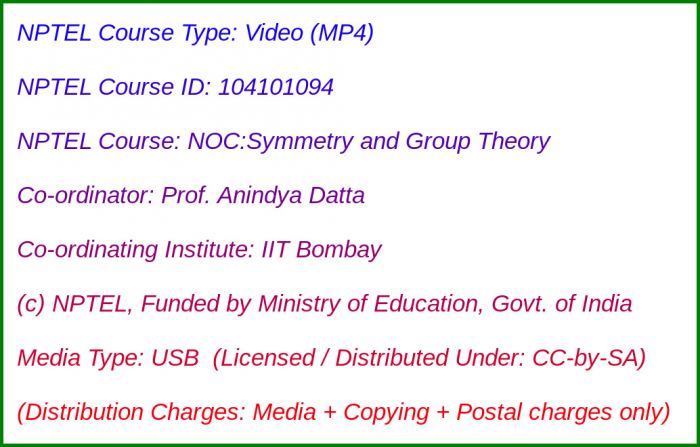
Media Storage Type : 64 GB USB Stick
NPTEL Subject Matter Expert : Prof. Anindya Datta
NPTEL Co-ordinating Institute : IIT Bombay
NPTEL Lecture Count : 68
NPTEL Course Size : 32 GB
NPTEL PDF Text Transcription : Available and Included
NPTEL Subtitle Transcription : Available and Included (SRT)
Lecture Titles:
Lecture 1 - Symmetry point group: Introduction
Lecture 2 - Symmetry point group: Examples - Part I
Lecture 3 - Symmetry point group: Examples - Part II
Lecture 4 - Symmetry point group: Examples - Part III
Lecture 5 - Symmetry point group: Examples - Part IV
Lecture 6 - Transformation matrices and Matrix representation
Lecture 7 - More on Matrix representation: Cartesian coordinates in C2v point group
Lecture 8 - Matrix representation: the way ahead
Lecture 9 - Introduction to Group Theory
Lecture 10 - Group Multiplication Tables
Lecture 11 - Groups and subgroups
Lecture 12 - Classes, Similarity transformations
Lecture 13 - Introduction to Matrices
Lecture 14 - Application of matrices in solution of simultaneous equations
Lecture 15 - Matrix eigenvalue equation
Lecture 16 - Matrix eigenvalue equation: an example
Lecture 17 - Similarity Transformations
Lecture 18 - Back to transformation matrices
Lecture 19 - Matrix representation revisited
Lecture 20 - Function space and Transformation Operators
Lecture 21 - Transformation Operators form the same group as transformation matrices
Lecture 22 - Transformation Operators form a unitary representation for orthonormal basis
Lecture 23 - Transformation Operators: Switching Bases
Lecture 24 - Equivalent representations
Lecture 25 - Unitary Transformation
Lecture 26 - Unitary Transformations (Continued...)
Lecture 27 - Reducible and Irreducible Representations
Lecture 28 - Irreducible Representations and Great Orthogonality Theorem
Lecture 29 - Character Tables: C2v
Lecture 30 - Character Tables: C2v and C3v
Lecture 31 - Practice Session: Review of Some Questions and Solutions
Lecture 32 - Reducible to Irreducible Representations
Lecture 33 - Character Tables of Cyclic Groups
Lecture 34 - Symmetry of Normal Modes: D3h
Lecture 35 - Symmetry of Normal Modes: D3h (Continued...)
Lecture 36 - Symmetry of Normal Modes: a shortcut
Lecture 37 - Recap: Reducible Representation for Normal Modes
Lecture 38 - Contribution of internal motion to normal modes
Lecture 39 - Normal mode analysis: some examples
Lecture 40 - Infrared and Raman spectroscopy
Lecture 41 - IR and Raman activity
Lecture 42 - IR and Raman activity: examples
Lecture 43 - Symmetry Adapted Linear Combinations (SALC)
Lecture 44 - SALC:BeH2
Lecture 45 - SALC:CH4 Introduction
Lecture 46 - SALC:CH4
Lecture 47 - Projection Operators
Lecture 48 - Projection Operators (Continued...)
Lecture 49 - Generating SALC’s using Projection Operators
Lecture 50 - Generating SALC’s using Projection Operators (Continued...)
Lecture 51 - Oh complex and Group-subgroup relation
Lecture 52 - Group-Subgroup Relation
Lecture 53 - SALCs as Pi-MO andCyclopropenyl group
Lecture 54 - SALCs as Pi-MO, Cyclopropenyl group
Lecture 55 - SALCs as Pi-MO, Benzene
Lecture 56 - LCAO Huckel approximation
Lecture 57 - Huckel approximation: Naphthalene
Lecture 58 - Stationary states, Multiplicity, Ethylene
Lecture 59 - Napthalene - I
Lecture 60 - Napthalene - II
Lecture 61 - Napthalene - III
Lecture 62 - Transition Metal Complexes: CFT and LFT
Lecture 63 - Jahn-Teller Theorem, Tetragonal Distortion MOT:ML6, Sigma and Pi Bonds
Lecture 64 - MOT approach of bonding,H2O,Ferrocene
Lecture 65 - MOT approach of bonding,H2O,Ferrocene
Lecture 66 - Derivation: Great Orthogonality Theorem - I (Schurrs Lemma 1)
Lecture 67 - Derivation: Great Orthogonality Theorem - II (Schurrs Lemma 2)
Lecture 68 - Derivation: Great Orthogonality Theorem - III

